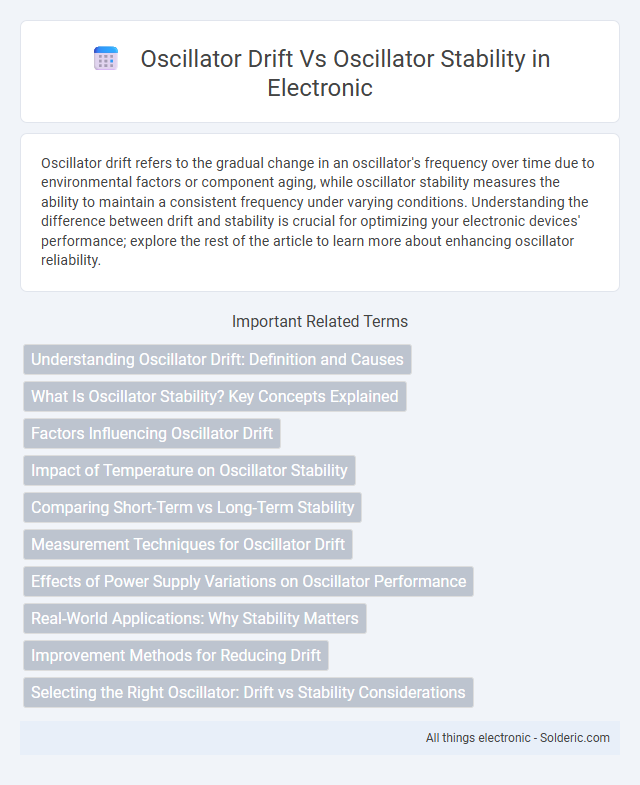Oscillator drift refers to the gradual change in an oscillator's frequency over time due to environmental factors or component aging, while oscillator stability measures the ability to maintain a consistent frequency under varying conditions. Understanding the difference between drift and stability is crucial for optimizing your electronic devices' performance; explore the rest of the article to learn more about enhancing oscillator reliability.
Comparison Table
| Feature | Oscillator Drift | Oscillator Stability |
|---|---|---|
| Definition | Change in oscillator frequency over time due to environmental or aging effects | Ability of oscillator to maintain constant frequency under varying conditions |
| Measurement | Frequency deviation in Hertz (Hz) or parts per million (ppm) over a period | Frequency variation, usually expressed as ppm or percentage over time and conditions |
| Causes | Temperature changes, aging, mechanical stress, supply voltage variation | Design quality, crystal cut, temperature compensation, material stability |
| Impact | Leads to cumulative frequency errors affecting timing and synchronization | Ensures precise timing and reduces frequency errors in critical applications |
| Control Methods | Periodic calibration, temperature control, environmental shielding | Use of TCXO, OCXO, high-quality crystals, and circuit improvements |
| Typical Units | Hz drift/hour or ppm per day/week | ppm stability over temperature range/time |
Understanding Oscillator Drift: Definition and Causes
Oscillator drift refers to the gradual deviation of an oscillator's output frequency from its nominal value due to environmental factors such as temperature changes, aging of components, and supply voltage variations. This frequency shift impacts the oscillator stability, which measures the oscillator's ability to maintain a consistent output frequency over time and conditions. Understanding the causes of oscillator drift is crucial for designing precision timing devices and minimizing errors in applications like communication systems and instrumentation.
What Is Oscillator Stability? Key Concepts Explained
Oscillator stability refers to the ability of an oscillator to maintain a consistent frequency output over time, despite changes in environmental conditions such as temperature, humidity, and power supply variations. Key factors influencing oscillator stability include frequency drift, phase noise, and aging effects, which collectively impact the precision and reliability of timekeeping and signal generation in electronic devices. High oscillator stability is crucial in applications like communication systems, GPS technology, and atomic clocks, where accurate frequency control ensures optimal performance.
Factors Influencing Oscillator Drift
Oscillator drift primarily results from temperature fluctuations, aging components, and supply voltage variations, which cause frequency deviations over time. Mechanical stress and environmental factors like humidity also impact oscillator stability by altering the resonator's physical properties. To maintain your oscillator's performance, it is essential to minimize these influences through proper design and environmental control.
Impact of Temperature on Oscillator Stability
Oscillator stability is significantly affected by temperature variations, as changes cause frequency drift due to material expansion and changes in component properties. High-quality temperature-compensated oscillators, such as TCXOs and OCXOs, mitigate this drift by maintaining frequency accuracy across diverse thermal conditions. Precise thermal management and robust oscillator design are critical to minimizing frequency instability in applications requiring long-term reliability.
Comparing Short-Term vs Long-Term Stability
Oscillator drift refers to the gradual deviation of an oscillator's frequency over time, impacting both short-term and long-term stability. Short-term stability measures frequency fluctuations over seconds to minutes, crucial for immediate signal accuracy, while long-term stability accounts for frequency changes over hours to days, affecting overall performance reliability. Understanding the differences helps you select oscillators tailored for precision timing or extended operational consistency in various applications.
Measurement Techniques for Oscillator Drift
Measurement techniques for oscillator drift primarily involve frequency counting using high-precision frequency counters and phase noise analyzers to monitor deviations over time under controlled environmental conditions. Time interval analyzers and Allan deviation analysis provide detailed insights into frequency stability and short-term variations, capturing both random fluctuations and systematic drift. Environmental chambers simulate temperature and humidity changes to assess oscillator resilience, enabling accurate characterization of long-term stability and drift performance.
Effects of Power Supply Variations on Oscillator Performance
Oscillator drift is significantly influenced by power supply variations, causing frequency shifts due to changes in voltage levels affecting the oscillator's active components. Oscillator stability depends on maintaining a consistent power supply voltage to minimize phase noise and frequency deviation. High-quality voltage regulators and power supply filtering techniques are essential to reduce the impact of power supply fluctuations on oscillator performance.
Real-World Applications: Why Stability Matters
Oscillator stability is crucial in real-world applications such as telecommunications, GPS systems, and precision instrumentation, where frequency accuracy directly impacts performance and reliability. Drift in oscillators causes signal degradation, timing errors, and synchronization problems, leading to system failures and reduced efficiency. High-stability oscillators ensure consistent frequency output over time and temperature changes, maintaining system integrity and operational accuracy.
Improvement Methods for Reducing Drift
Improvement methods for reducing oscillator drift primarily involve temperature compensation, such as using Temperature Compensated Crystal Oscillators (TCXOs) and Oven Controlled Crystal Oscillators (OCXOs) to stabilize frequency against environmental changes. Advanced materials and precision manufacturing also enhance oscillator stability by minimizing aging effects and mechanical stress. Implementing digital calibration and automatic frequency control further reduces drift by continuously correcting deviations in real-time operations.
Selecting the Right Oscillator: Drift vs Stability Considerations
Selecting the right oscillator requires balancing oscillator drift and oscillator stability to ensure accurate frequency output over time and varying environmental conditions. Oscillator drift quantifies the frequency deviation due to aging, temperature, and power supply variations, while oscillator stability measures the oscillator's ability to maintain a consistent frequency under specified conditions. For precision applications, choosing an oscillator with low drift and high stability, such as a temperature-compensated crystal oscillator (TCXO) or oven-controlled crystal oscillator (OCXO), optimizes performance and reliability.
oscillator drift vs oscillator stability Infographic

 solderic.com
solderic.com